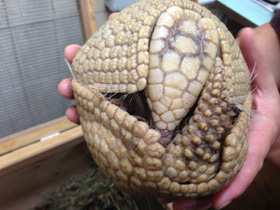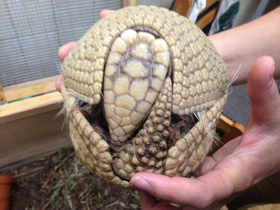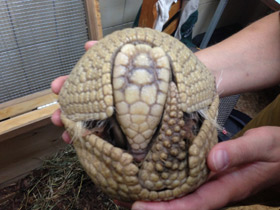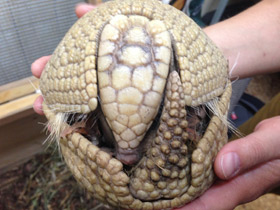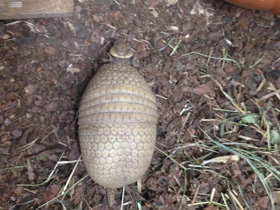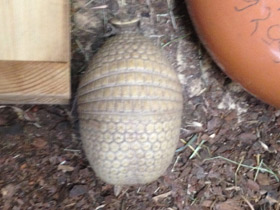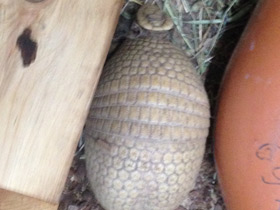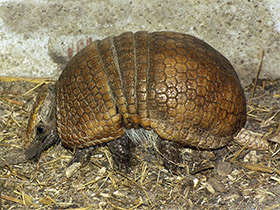Genus Tolypeutes
The animals of this genus (which includes only two species) are found in the south-eastern and central parts of America, in the south of Mexico, in Chile, Argentina, and Uruguay. They prefer open habitats but can also occur in the forests. Three-banded armadillos are solitary animals which are mainly active at night. When threatened, they try to escape and hide in the burrows or other shelters. Main characteristic of three-banded armadillos is the bony armour that covers their backs and sides, and a long tail (2.5 to 50 cm). The armour consists of three characteristic bands allowing the animal enough flexibility to fit its tail and head together. The undersides of three-banded armadillos have sparse hairs; in some animals the hairs grow also on the back, between the plates of the armour. The armour of these armadillos is shiny, with the colour ranging from pink to brown. The hairs are mostly white and can be greyish-brown on some parts of the body. The snout may have different shape, from short to elongated. These animals have tiny eyes with thick eyelashes, and small ears. Their forefeet have four or five digits equipped with long, curved powerful claws. Three-banded armadillos have perfect olfactory sense and well-developed hearing. Their diet includes insects, small invertebrates, plants, and carrion. Special characteristic of the three-banded armadillo reproduction is a long gestation period associated with the delay of implantation of the fertilized egg. Usually the female gives birth to a single young. The newborn is covered in soft leathery skin and is able to walk in a few hours though it stays in the den for several months. Young three-banded armadillos reach sexual maturity by the age of approximately two years.
The southern three-banded armadillo Tolypeutes matacus
The southern three-banded armadillo is a small animal with the body length of up to 35 cm. It weighs about 1.5 kg. Southern three-banded armadillos are heavily armored with a thick, leathery shell that is usually segmented into three bands covering the head, legs, tail, and dorsal part of the body. The southern three-banded armadillo is remarkable for being one of the few armadillo species capable of rolling into a ball: when threatened, these armadillos roll themselves up into a ball, leaving only a small opening between the shell edges. If the animal is prodded through the opening, it snaps shut like a steel trap causing pain and possibly injury to the predator. The southern three-banded armadillo is found in South America, from eastern Bolivia and south-western Brazil, south through Paraguay, to northern and central Argentina. These armadillos live in areas of dry vegetation and may also occur in grasslands, and marshlands. Unlike other armadillo species, the southern three-banded armadillo usually does not dig burrows, and instead shelters in the abandoned burrows of other animals such as anteaters. Other distinctive features of the southern three-banded armadillo are the second, third and fourth toes of the hind feet, which bear hoof-like claws, while the fore feet possess sharp, powerful claws. The southern three-banded armadillo eats mainly ants and termites. It uses its strong legs and large claws to dig through insect colonies or under bark to get to the insects. These animals also use their long, sticky, straw-like pink tongues for gathering up their food.
Three-banded armadillos are primarily solitary. They breed successfully in captivity, with a female giving birth to a single pup. Their longevity in captivity is 15 to 20 years.

















